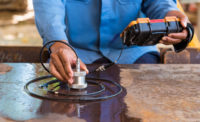Having attended a traditional classroom setting for my NDT education, I experienced the value of direct instructor interaction as well as the benefit of being able to put my hands on the various types of equipment. Although I attended a well-known NDT college for my education, it was not what a person would consider as a “traditional educational format.” For the most part, the students navigated their way through the courses by themselves, some learning faster and some at a slower pace. Instructors had no structured lectures, but they were available when needed by the individual student. Students came and went from class as they pleased depending on their personal learning pace, completing quizzes, watching video lectures, taking final exams, and performing hands-on tasks with various pieces of equipment.
After graduation I started my career in NDT on the North Slope of Alaska as a radiographer’s assistant where I soon found that all the classroom training, equipment familiarization, and knowledge that was imparted to me at college was just a small base of what I really needed to know. This is when it became clear as to why the NDT training requirements are made up of two parts, classroom/theory training followed by on-the-job training (OJT). I realized that the classroom/theory training was to give me an in-depth understanding of the physics of the various nondestructive testing methods and the much larger part of the training format, OJT, was to provide me with the practical skills to do the job on a day-to-day basis.

The Changing World of NDT Training
 Donald Booth of the American Institute of Nondestructive Testing now offers a range of NDT training options for others in the industry. Listen now to how training has changed over the years and how to get the most out of your classroom and on-the-job training.
Donald Booth of the American Institute of Nondestructive Testing now offers a range of NDT training options for others in the industry. Listen now to how training has changed over the years and how to get the most out of your classroom and on-the-job training.
Listen to more Quality podcasts.
So, the question bears asking, “Where does the bulk of NDT training responsibility lie, in the classroom or in the field?” For example, Radiographic Level I and II each require forty hours of documented classroom/theory training followed by eight hundred and forty hours of combined field experience, or OJT, prior to being qualified to be certified. The bulk of required training lies in the OJT. This is where a technician’s skills, habits and techniques are shaped with the help of an experienced Level II or III technician. Both training components are important in their own way as we know the objective of the training is to prepare the student for certification. I feel the classroom/theory training portion is most important to prepare the student to be able to pass their general certification exam, and the OJT portion of training is to prepare the technician to pass their specific and practical portions of their certification exam.
OK, now let’s look at the evolution of NDT training starting with the traditional classroom format, followed by the advent of online training and online/hands-on blended training and the benefits of each.
Traditional Classroom Training
The classroom setting for NDT training typically includes a lecture area equipped with tables, chairs, and audio-visual equipment for presentations. The environment is designed to foster interaction between the instructor and the participants, as well as among the participants themselves. Instructors use a mix of lectures, discussions, demonstrations, and multimedia presentations to teach the principles and practices of NDT. This might include:
Textbook and reading assignments for foundational knowledge and understanding of concepts, PowerPoint presentations to highlight key points, methodologies, and case studies, hands-on demonstrations to show real-world applications of NDT techniques and video materials to illustrate processes and techniques that are difficult to replicate in a classroom setting.
While a significant portion of NDT training is theoretical, a traditional classroom course also includes hands-on learning opportunities such as sample testing where students practice on test pieces to identify and evaluate flaws, equipment usage with instructions on the proper use, calibration, and maintenance of NDT equipment, and lab sessions where students can apply classroom knowledge to real-world scenarios under the supervision of an instructor.
Advantages of Traditional Classroom Training for NDT
- Direct Interaction: Immediate feedback and personalized instruction from qualified instructors.
- Structured Learning: A defined schedule that can enforce discipline and systematic learning.
- Group Dynamics: The chance to learn from the questions and experiences of other students.
- Focus: A dedicated learning environment free from the distractions of a workplace or home setting.
In summary, traditional classroom training for nondestructive testing is an immersive educational experience that combines theoretical instruction with practical application. It is suited to individuals who benefit from face-to-face instruction and the structured environment of a physical classroom.
Online NDT Training
Online training for NDT has become increasingly prevalent, offering a host of benefits that cater to the evolving needs of learners and the industry. Here are several advantages of adopting an online training model for NDT:
- Global Reach: Online training can be accessed by anyone with an internet connection, removing geographical barriers and allowing for a more diverse student base.
- 24/7 Availability: Learning materials can be accessed at any time, which means that students can study around their existing commitments, such as work or family.
- Self-Paced Learning: Individuals can progress through the course at their own speed, pausing and reviewing material as necessary to ensure understanding.
- Customizable Learning Paths: Learners often have the option to select specific modules or courses that align with their career goals or interests.
- Reduced Costs: There are often significant cost savings since there is no need for travel, accommodation, or printed material.
- Multimedia Content: Online courses typically utilize a mix of text, images, videos, and interactive content, which can enhance understanding and retention of complex concepts.
- Up-to-Date Information: Course content can be updated rapidly to reflect the latest industry standards, regulations, and technologies.
- Uniformity of Training: Every student receives the same instruction, which promotes consistency in the quality and level of training.
- Documented Progress: Online platforms often track and report on a learner's progress, providing a transparent record of achievements and areas for improvement.
In essence, online training for nondestructive testing offers a modern, efficient, and learner-centered approach to professional education. It allows for a high degree of flexibility and personalization, making it an appealing option for individuals and organizations seeking to enhance their knowledge and skills in the field of NDT.
Blended NDT Training
Blended nondestructive testing (NDT) training is an educational approach that combines online learning (e-learning) with hands-on laboratory training. This hybrid model merges the convenience and flexibility of digital coursework with the critical practical experience gained in a lab environment. Here are several benefits of blended NDT training:
- Self-Paced Learning: Online components allow learners to progress through theoretical aspects at their own pace, making it ideal for those with varying learning speeds or busy schedules.
- Geographical Flexibility: Participants can access digital materials from any location, reducing the need for travel and allowing for a wider reach to students who might not be near a training facility.
- Variety of Resources: E-learning platforms often offer a diverse range of resources, including videos, interactive simulations, and forums, which can cater to different learning styles.
- Continuous Access to Materials: Learners can revisit online course materials as often as needed, which is particularly beneficial for complex or challenging topics.
- Reduced Costs: With less need for physical materials and classroom space, and decreased travel expenses, blended NDT training can be more affordable for both the training provider and the participants.
- Resource Efficiency: Online training modules can be updated more quickly and easily than printed materials, ensuring that learners always have access to the most current information.
- Hands-On Training: Laboratory sessions provide the essential hands-on experience required for proficiency in NDT methods, ensuring that students can apply theoretical knowledge to real-world scenarios.
- Equipment Familiarity: In-lab training offers exposure to the actual NDT equipment and tools that professionals will use in the field, fostering a deeper understanding of their operation and maintenance.
- Peer Interaction: Blended programs can foster a community of practice through online discussions and collaborative projects, as well as during in-person lab sessions.
- Instructor Support: Learners can receive guidance from instructors both online and face-to-face, allowing for a well-rounded support system.
Blended nondestructive testing training provides a comprehensive and contemporary approach to NDT education. It successfully integrates the convenience and modernity of online learning with the irreplaceable value of hands-on practical experience, preparing students for a successful career in NDT with a rich and adaptable skill set.
Whatever format of training that you or your company chooses, be sure to weigh the benefits of each as well as ensure to provide a robust on the job training component to support the initial classroom/theory portion of the training system.



